Since ages women have been in love with Assam silk sarees, as these boast of opulence.
But do you know where and how these beautiful sarees are woven?
Let us take you on a virtual tour to Assam’s Sualkuchi: the weaving village where these sarees are woven!
Introduction

Sualkuchi is known as the ‘Manchester of the East’ and ‘Silk Village of Assam’.
It is situated 35 km from Guwahati on the northern banks of the river Brahmaputra.
The Sualkuchi village is famous for its weaving heritage and is a block of the Kamrup district of Assam.
The place is famous for a variety of silk weaves that include Golden Muga Silk, Ivory White Pat Silk, and Light Beige Eri or Endi Silk.
Sualkuchi produces nearly 6 million meters of Assam silk annually and is said to have over 25,000 looms.
It was declared a ‘Handloom Heritage Village’ and has become a hot tourist destination of Assam.
Recommended Story – Top Startups Promoting Fabric Crafts of India
History

The tradition of silk weaving in Sualkuchi developed during the reign of king Dharma Pal of the Pala dynasty in the 11th century.
The king sponsored the craft and brought 26 weaving families from Tantikuchi to Sualkuchi.
Hamlet took the shape of a weaving village in the royal patronage of the Ahoms during the 17th century.
The weaving industry of Sualkuchi got a major boost only during the Second World War as cloth-making had increased.
Livelihood
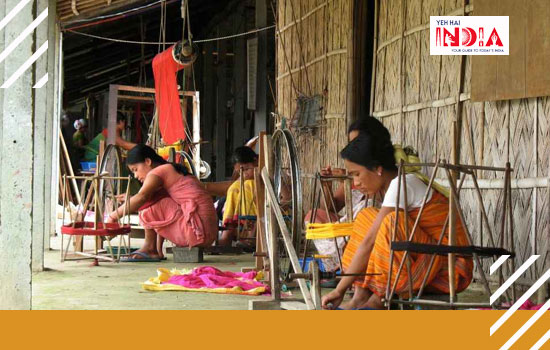
Most of the village people had no formal training in handloom weaving, they learnt the art from their parents.
Almost all the families are involved in weaving so most of the houses have their own weaving looms.
The fabrics are hand woven on wooden frame looms, using both indigenous silks and different kinds of yarns.
The ivory paat silk, beige eri, and the golden muga silk threads are used in making exquisite Mekhela chadors, saris, shawls, dress materials, rihas, and gamochas.
It becomes quite difficult to differentiate a home extension housing a loom or a family run establishment from a purely commercial work-shed.
The production is not only for self-consumption but for the purpose of sale.
There is no gender bias involved in weaving; both men and women are involved in weaving.
Project Sualkuchi
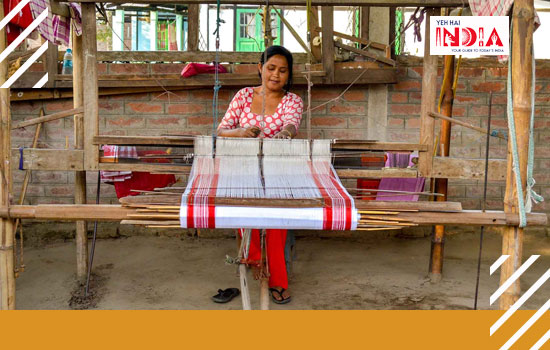
In 1987, the North Eastern Council launched the ‘Project Sualkuchi’ – to help the weavers of Sualkuchi.
The main objectives of this project were:
- Provide self-employment to the rural folk.
- Make Self-help groups for the empowerment and sustenance of these weavers
- Impart managerial and technical skills to these poor weavers.
- Build a team of resourceful people who can help in upskilling the weavers.
- Enhance the skills of the weavers through proper training and thereby increasing their numbers.
- Facilitate proper utilization of Muga, Eri yarn products using the Yarn Bank.
- Produce superior quality products under strict quality checks.
- Create a proper marketing support in the village itself
- To help weavers enhance their overall income generation.
The launching of the Sualkuchi Project has led to a large inflow of expert weavers from other districts.
Migrant weavers who work on wages are outnumbering the local weavers today.
In the present day, fabrics like cotton and khadi are also woven, but silk weaving is still the most prominent here.
The ratio of women weavers is more compared to their male counterparts.
Recommended Story – Straight From The City Of Ghats: Banarasi Sarees
Process
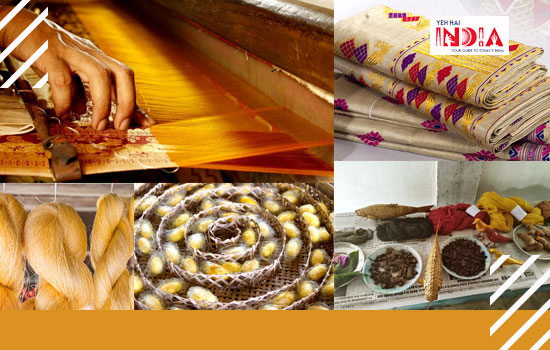
- Firstly, the desired motifs are drawn on graph paper by the artisans.
- These woven motifs are generally inspired by the flora and fauna found in Assam, consisting of peacocks, rhinos, deer, and flowers.
Another common type of motif is the ‘Jaapi’ (traditional Assamese hat).
- Once the blueprint of the design is made, the weaver starts making punched cards.
- For making a punch card, holes are punched on rectangular cardboard pieces along the lines of the design.
- Depending on the design of the saree it can take a weaver six to eight days to complete the weaving of one saree.
In the past, golden Zari was used to create the motifs but now silk and cotton threads are used to make them.
Nowadays, new colorful fabrics are being made to suit current urban tastes.
Jacquard technology too is widely used, enabling mass production of intricate motifs.
In the present day, along with sarees a wide range of ladies and men’s wear are being produced.
Such as dupattas, fabrics, garments, handkerchiefs, caps, scarves, dhotis, turbans, shawls, ghagras or lehengas, and even quilts, bedcover, tablecloths, cushions, curtains.
Sualkuchi has indeed come a long way and is exporting their silks to foreign countries too!
Also Read – Sutrakaar Creations – More than just writing on paper!


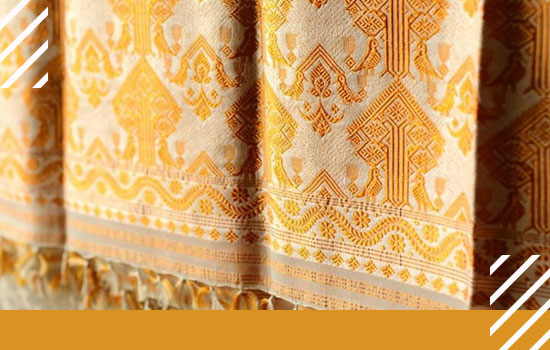


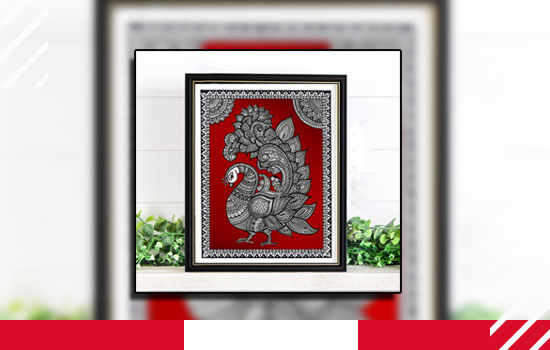





Is it possible to share the weavers contact no.s?
Very informative. Loved the article
So informative. Loved the article.